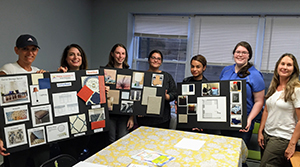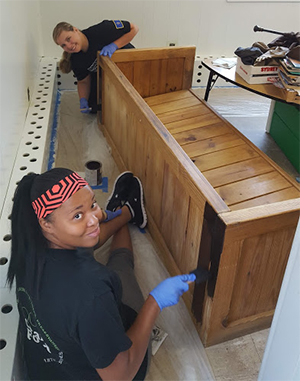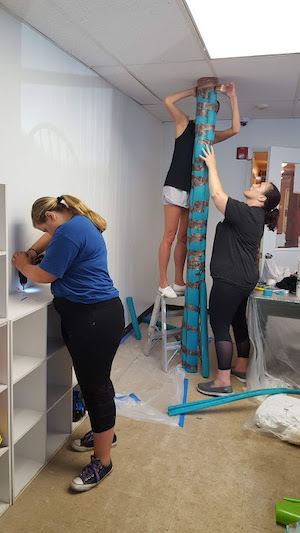Authentic Assessment: Transforming Lives, Building Communities · Trudy Christ (Assistant Professor, Interior Design, Eastern Campus)
 “Suffolk County Community College promotes intellectual discovery, physical development, social and ethical awareness, and economic opportunities for all through an education that transforms lives, builds communities, and improves society.”
“Suffolk County Community College promotes intellectual discovery, physical development, social and ethical awareness, and economic opportunities for all through an education that transforms lives, builds communities, and improves society.”
In all of my classes, I work hard to try to fulfill the very public institutional promise made in our official SCCC mission statement. Many of us focus on transforming our students’ lives, but I’d like to show how developing authentic assessments in our classrooms can help us also meet the commitment to building communities and improving society as well.
I realize that interior design is a smaller career focused program, but the principles I incorporate in my classes can absolutely be implemented across different disciplines. If anyone thinks it’s too much work or too much extra time, remind yourselves that it is worth that extra time if we truly want what’s best for our students, communities and our college. I’ve seen the impact on students, where relatively quiet students just shine and excel, both within their team and individually, creating new self-confidence and learning pathways.
So I invite you to make some time for authentic assessment opportunities. Think of it as a tradeoff: Wouldn’t you rather do these kinds of engaging authentic assessments than wade through stacks of essays or sit through yet more presentations? Think about it.
Making choices about how to measure student learning
As faculty, we all make choices about how to measure student learning in our classes. Using the student learning outcomes, we develop various assessments to help us determine whether or not students are achieving them.
In the interior design program, students are typically taught through a combination of lecture, reading assignments, and worksheets. Then they are presented with a floor plan and client profile for which they gather information about the site and clients, analyze the data, and distinguish client wants versus needs. We ask students to create projects in which they apply their knowledge, all while evaluating and re-evaluating their progress as they develop the best possible design. Projects culminate in a visual and oral presentation to the class.
To be honest, like most faculty in the disciplines, I could rely on a series of homework, quizzes, tests, and this class presentation as the means of assessing my students. It would suffice. Yet I keep thinking about the college mission statement as well as my own knowledge of what our field can contribute in the world. So I am constantly seeking new opportunities for students to apply their skills in actual physical spaces—and to make a real difference in our communities.
Authentic work benefits Brighter Tomorrows and Boys & Girls Club
 In 2018 I was an adjunct here and an acquaintance who serves on the board of the Brighter Tomorrows domestic violence shelter reached out to me regarding assistance with design for one of their safe houses. I met with the director, and we worked out a volunteer project for SCCC interior design students. I was impressed by the enthusiasm with which students really responded to this project!
In 2018 I was an adjunct here and an acquaintance who serves on the board of the Brighter Tomorrows domestic violence shelter reached out to me regarding assistance with design for one of their safe houses. I met with the director, and we worked out a volunteer project for SCCC interior design students. I was impressed by the enthusiasm with which students really responded to this project!
That modest project has grown over the years and it has now become embedded in my Design III course, which is typically done in the third semester. Over the years, our projects have included designing or redesigning the bedrooms, children’s playroom and living room at their main shelter, and an entire safe house. We now have a very structured partnership with these nonprofit organizations, and it’s one of the students’ favorite parts of our curriculum.
Students meet with and interview the clients, take site measurements and establish budgets. Materials are often donated or sometimes the organization has funding earmarked for these specific projects—the Boys & Girls Club, for instance, had $15,000 for students to work with—and they learn to work within the organization’s specific parameters. Then students research codes and analyze and evaluate their data.
They create floor plans and develop presentations for the boards of each organization. Once designs are approved, students are responsible for obtaining all necessary elements that go into their design, such as furniture, materials, and accessories. For example, the Boys & Girls Club needed a sofa, so I reached out to a showroom I work closely with and they donated a sofa. If the organizations don’t have items available, in the past we’ve reached out on campus and colleagues have come through with everything from lamps to artwork.
These nonprofits are typically thrilled to work with our students, and it represents a significant cost savings to the organizations.
Developing the whole student
As a professor, I focus not just on creating interior design graduates but on helping the whole student develop. We are creating lifelong learners who will be out in our communities and making a difference in a wide variety of ways. We need to inspire them to make their work meaningful, and we can do that by modeling the behavior for them in how we structure our classes.
For example, as part of these partnerships, students often engage in painting days on site. As an interior design professional, they will not be expected to do painting for clients. Professional painters do that work. However, it’s great experience for them to do this painting so they have a better appreciation of the time and labor that goes into the work.
This kind of hands-on, place-based learning also gives them real experience in project management, interacting with a variety of personalities, and dealing with unexpected issues that arise. This builds their confidence in understanding all that is involved from concept to completion. When learning only on campus, they don’t have to deal with the give-and-take that inevitably happens. For example, a student might begin with an idea like “This is a domestic violence shelter room for little girls; I am thinking it should be painted pink,” but speaking with representatives from Brighter Tomorrows, they might hear why it’s better to go with a more neutral color and their sensitivity to gender fluidity. These kinds of conversations happen all the time on the job.
Authentic assessment is truly meaningful
 Of course, this kind of hands-on learning might seem easier to accomplish in a discipline like mine. But, again, I don’t have to do any of this. I choose to because it makes our program so much more meaningful for students. As 2022 graduate Claire Teifer asserts, “physically being on site offers a higher level of inspiration and connection to the space that any hypothetical project could.”
Of course, this kind of hands-on learning might seem easier to accomplish in a discipline like mine. But, again, I don’t have to do any of this. I choose to because it makes our program so much more meaningful for students. As 2022 graduate Claire Teifer asserts, “physically being on site offers a higher level of inspiration and connection to the space that any hypothetical project could.”
Don’t take my word for it. Consider what our students have to say.
Samantha Intagliata participated in both the Brighter Tomorrows and Boys & Girls Club projects. “There were several things to account for, including building codes, budgets and client needs, creating invoices and specification sheets,” Samantha explains, but “aside from the design portion there was a human element to the work that could not be obtained in a classroom. We had to understand the position of our client and some of the hardships they may be facing emotionally and physically to create a space that can nourish and lift up them.”
Samantha found Brighter Tomorrows especially fulfilling because “the staff themselves care so deeply about their community, and working with them was enlightening. The idea that this space can be a new happy place where women and children can finally breathe again made me feel grateful that I was a part of this experience.”
“One of my biggest hopes,’’ she adds, “is that these women and children understand that they are loved, even by strangers, and deserve to have a healthy and happy future.”
Claire Teifer absolutely agrees, noting, “I felt such a tremendous amount of gratitude to work on this project. The women and children are living there during such an incredibly difficult time. I hope these spaces we helped create are a true sanctuary in that time.”
Also involved at Brighter Tomorrows, Karina Santander had a different reason for finding it so meaningful. “As someone who left her home country and immigrated to the US at a young age, I understood their needs and what they were feeling. Being in a new place, having their own space where they could feel at ease or at home, I believe it’s essential for someone, in this case these women and children, and being able to help other people to achieve happiness and peace makes me happy as well.”
The element of group collaboration was profound for Jessica Boyle, who contributed to the Boys & Girls Club project: “I also learned the importance of working in a team. My team and I all found our individual strengths in this project and came together to create a beautiful space that we hope the children and staff will love for years to come.”
Samantha agrees. “Working with a tight budget meant we had to prioritize certain elements which made finding well-made, affordable products one of the harder tasks. Our group was able to budget by upcycling pieces of furniture and creating our own accessories. It was exciting putting our own personal skills to the test, everyone did amazing work, and if we had a higher budget, we may never have seen our potential.”
As a parent, Susan Gunning was moved by the opportunity to work on the early education room for the Boys & Girls Club. Susan notes, “This struck close to home since I have two children of my own. The early education classroom meant creating a space where the students would be set up for success. I was able to imagine a space where the children could thrive. It meant a lot being able to serve a community and allow their futures to be bright.”
“It was an honor,” Susan asserts, “to be working on this project.”
Also at the Boys & Girls Club, Nicole Ruggiano was assigned to the teen lounge, and Nicole too found the work deeply meaningful.
I connected with what the Boys & Girls Club stands for on a personal level. When my group was assigned the teen lounge and we were informed that this area is the least used and the teens aren’t coming to the facility, it was important to me and my group to really do something about it and create an atmosphere that was cool and welcoming.
My heart was more pulled to this project to find a safe place for these teens that they would WANT to go to. The measuring and presenting was all great for learning, but the reasoning behind it was what moved me.
Working on this type of project meant hope. Possibility. Stability for these teens. It meant using what we had learned and applying it for a group of people that would really appreciate it on a deeper level and bring them into a safe space.
This kind of student feedback does not come after midterms and final exams. I believe we all can and should work hard to integrate truly meaningful, purposeful and authentic learning opportunities into our classes. It not only transforms our students but also benefits our local communities.








